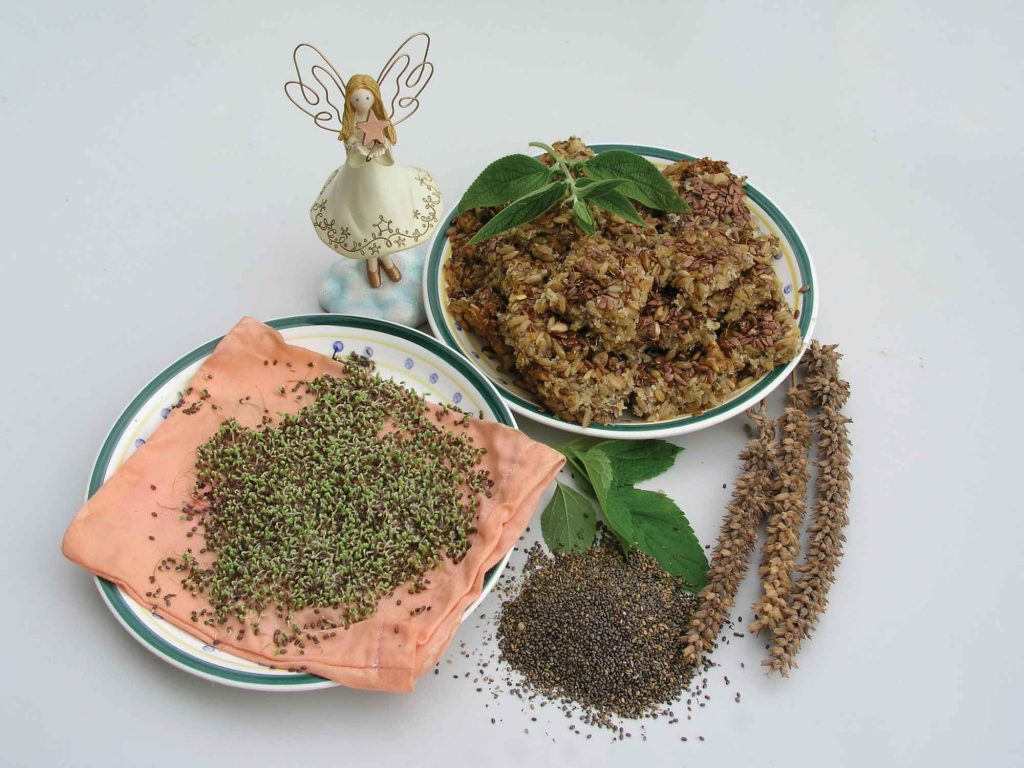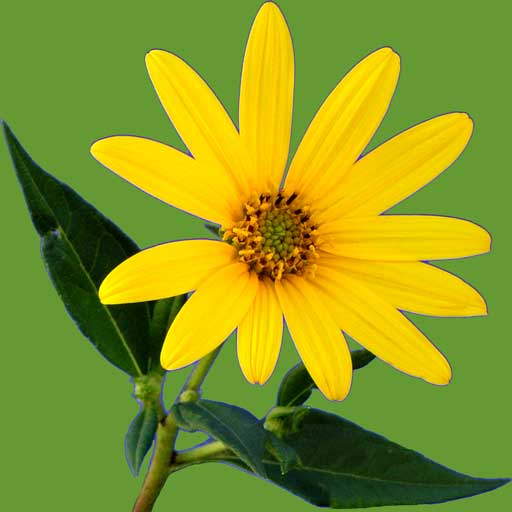Salvia rhyacophila F. Lamiaceae
… … omitted text, please see How can I grow and use Sprouts as living food? for full text.
Constituents:
linolenic and linoleic acid; antioxidants chlorogenic acid, caffeic acid and flavonol glycosides; mucin, fibre, protein 30% with 8 essential amino acids (amino acid score 115, making chia an excellent protein source)
Vitamins:
A, B1. B2, B3, B5, B6, B15, B17, C, D, E, K, choline, folic acid, inositol, PABA
Minerals:
boron, calcium, copper, iodine, iron, magnesium, manganese, molybdenum, phosphorous, potassium, silicon, sodium, strontium, sulphur, zinc
Actions:
antifatigue, antihyperglycaemic, antiinflammatory, antioxidant, cardiotonic, demulcent, laxative, nervine, neuromuscular stimulant, nutritive, tonic, vulnerary

Medicinal Uses
In the native habitat of chia, in South West America, it was a highly valued food plant of the local Indians. In Mexico, it was used as money and to pay taxes. One tablespoon of seed and plenty of water supplied energy and sustenance, for an Indian traveling for 24 hours: it is said that an Indian can exist on it for many days, if necessary. Several USA universities have researched the endurance properties of chia and found that a tablespoon of seed could sustain a person for 24 hours, with hard labour. Richard Lucas, in his book, ‘Common and uncommon uses of herbs for healthy living’, encourages anyone to try it, and discover its unique ability to provide the go power to get through a busy day with a hop, skip and a jump.
The calcium content of chia seed is 5 times that of milk. Chia seeds contain the trace mineral strontium, which acts as a catalyst in the assimilation of protein and production of energy. A greyhound breeder read of the energy boosting power of chia, and rang to see if he could buy the seed in large quantities, to give his dogs a winning edge! Researchers find that strontium has a strengthening benefit to cartilage, teeth and bones. Enzymes in chia, act as catalysts to aid the digestion of food.
The seeds contain one of the highest known sources of Essential Fatty Acids (EFA) as linolenic acid (LNA) 30-60%, and linoleic acid (LA) 30%. EFA’s carry a slightly negative charge and spread out as a thin layer over surfaces and do not form aggregations; this makes cell membranes soft, fluid and flexible, allowing nutrients to flow in and wastes out. Researcher, Linus Pauling, found that energy charged by EFA’s produced measurable, bioelectrical currents. These currents make possible the vast number of chemical reactions in the body, which are important in nerve, muscle and membrane function. EFA’s absorb sunlight and attract oxygen. A bounteous supply of oxygen, carried with the blood to the cells, is vital for vitality, pain relief and healing. The oxygen, is able, to be held by the action of EFA, at the cell membranes, making a barrier against viruses and bacteria. EFA’s are important in immune function and metabolic reactions in the body resulting in fat burn, food absorption, mental health and the process of oxidation and growth. They can substantially shorten the time required for recovery of fatigued muscles after exercise or physical work.
EFA’s are the highest source of energy in nutrition and govern every life process in the body. Life without EFA’s is impossible. When EFA’s are deficient, a diversity of health problems may follow (see EFA’s p 105) Due to high refining and processing of many natural foods, EFA’s may be low or non-existent, therefore, we need to look at what we can grow to give us these essentials, daily. Chia seeds provide a rich source of EFA’s, and many other seeds that we use for sprouting are also a good source.
The mucilaginous properties of the seeds, have a swelling action, similar to guar or psyllium as a bulking agent and fibre source, and are valuable for cleansing and soothing the colon. Chia acts like a sponge, absorbing toxins, lubricating the colon and strengthening the peristaltic action. Considering the high incidence of bowel cancer, diverticulitis, colitis, chronic constipation and irritable bowel syndrome, in our country, we need to share the knowledge of this healing plant with our fellow man. Chia seeds come to the rescue when the tummy is upset and will not tolerate other foods; or to fortify the body against the exhaustive effects of extreme summer temperatures. The seed helps to quench the thirst, if added to a glass of water, a very practical benefit in our hot summers. It is an appetite satisfier and, therefore, useful to dieters. Chia is valued for calming the nerves and is said to strengthen the memory: use 1 teasp. chia seed to 1 cup of boiling water, steep 5-10 minutes, take 2-3 cups a day. A poultice made of soaked seed is used as a wound healer. The early American settlers used chia for gunshot wounds.
Chia belongs to the salvia family, with the name coming from the Latin ‘salare’ which means to save, referring to its curative properties. Chia leaves (fresh or dried) steeped in boiling water, make a therapeutic tea. Use the tea as a blood cleanser and tonic, also for fevers, pain relief, arthritis, respiratory problems, mouth ulcers, diabetes, diarrhoea, gargle for inflamed throats, to reduce blood pressure, cholesterol and triglyceride levels and to strengthen the nervous system. Try the tea sweetened with honey and a few drops of lemon juice added. Women who suffer with hot flushes may find relief, by drinking chia leaf tea, regularly.
A recent TV program highlighted the benefit of chia tea, made with a few, freshly chopped leaves, for anyone feeling lethargic or lacking energy. As chia contains a number of strong antioxidants: in chlorogenic acid, caffeic acid and flavonol glycosides, no doubt all these work to remove toxins from the body, which then give a feeling of improved health.
The human body is able to digest chia seed, easily. As the seeds are able to absorb more than 7 times their weight, in water, and form a thick gel, this causes a slow release of carbohydrate; facilitating an equally slow conversion of carbohydrates, into glucose (blood sugar), for energy. The outer layer of the seeds are rich in mucilloid soluble fibre and, when mixed with water or stomach juices, a gel forms that creates a physical barrier between the carbohydrate foods eaten and the digestive enzymes that break them down. This means that the carbohydrates are digested slower and at a more uniform rate. There is no insulin surge needed to lower the blood sugar level, after eating chia. The chia gel is able to hold moisture, which also retains electrolyte balance.
Chia sprouts can come to the rescue for digestive problems, particularly when ‘windy’. Passing gas may be relieved by slowly chewing 1-2 tablesp. of chia sprouts, making sure that plenty of saliva is mixed with them. Together with the nutrients, chlorophyll, and enzymes from the saliva, the combination can act to relieve and prevent flatulence.
A tea made with chia seeds is used, as a wash, for removing foreign particles in the eye; also for relieving inflammation, eyestrain and conjunctivitis. Simmer 1 teasp. chia seed in 1/2 cup of water 5 minutes, cool, strain, use the liquid as a wash in an eye-bath. Seed soaked in water makes a thick, creamy mush, to use as a drawing poultice on infected cuts, wounds or inflammation.
Culinary Uses
Chia seeds are very tasty, with a nutty flavour, when sprinkled over meals. However, as it is difficult for the body to digest small, whole, dry seeds, unless chewed very well, it is recommended that seed be soaked in a little water (for several hours or overnight, to start the seed germination process) giving better assimilation, when eaten. Soaking is also beneficial, since vitamin C will start to be manufactured. When seeds are sprouted, the vitamin content multiplies considerably and they can add a spicy, warm flavour to meals. Sprinkle soaked seed over breakfast cereal or tossed salads.
Try chia as a refreshing breakfast drink. Mix 1 teasp. seeds (rich in soluble fibre), in a glass of orange juice and let the seed soak for 10 minutes, before drinking. The drink will give a feeling of satisfaction and fullness for a number of hours. It has been found that chia can help to regulate sugar metabolism. Research has found that enzymes in chia act as a catalyst, to aid the digestion of food. As chia has a low glycaemic index, it is an ideal food to add to our daily diet (information on GI p 22) Experiment using chia seeds added to different foods and drinks. For a refreshing chia beverage, soak 1 teasp. chia seed in 1 cup of hot water and 1/2 teasp. apple-cider vinegar, 1 teasp. honey and a pinch of cinnamon powder.
Add seed to cooked or baked goods. A small amount of seeds added, when making bread, will make bread lighter, with less leavening needed, as well as improving the keeping qualities. Note: as essential fatty acids (EFA) are not heat stable, to get the benefits of EFA in chia, the seeds are best used unheated. Many foods are said to be more flavoursome, with chia added; bitter foods become more palatable, sharp cheese, at maturity, will taste more like cottage cheese. Chia is useful for enriching baby foods, infant formulas, health foods, energy bars, snacks, breakfast cereals, etc. I like to chew on chia and fennel seeds (p 112) as I sit, research and write, long hours into the night.
As oxidation of chia seed is minimal to non-existent, it holds excellent potential within the food industry compared to other alpha-linolenic fatty acid sources, such as flax, which exhibits rapid decomposition due to lack of antioxidants. Chia does not need artificial antioxidant stabilisers and stores well, without deterioration. Chia seed can be stored for later use. I have observed that weevils and other pests never bother the seeds. This fact, together with the rich source of EFA’s, protein, vitamins, minerals, and antioxidants, makes chia a valuable survival food.
And when the garden yields a super crop, feed the seed heads to the hens. Research in South America, with commercial egg production, found that, in feeding hens, 30% of chia seed in their food was enjoyed, by the hens. This also resulted in the production of eggs with a ratio of saturated to polyunsaturated fats, half that found in normal eggs, a real benefit to consumers, eggs with a heart-friendly profile! And, for an enjoyable, sweet snack, with no baking, try…
Chia honey chews Melt 125g butter, 3/4 cup honey and simmer 5 minutes. Take off heat, add 1/4 cup chia seed, soaked in 1/4 cup water 12 hours, 1/2 cup flax seeds and 1⁄2 cup sunflower seeds, soaked 12-24 hours and drained; add 4 cups puffed millet, or rice bubbles or cornflakes, 1/2 cup coconut; mix well, press into a 30 x 15cm tin. This mixture needs to be fairly dry, so that it can be pressed down, firmly, in the tin, to set. If too moist, add a little more of the millet, rice or cornflakes. Cool. Refrigerate 1 day to let the flavours blend, cut into squares (p 74). Sesame seeds could be substituted for chia.
Chia lemonade Soak 2 teasp. chia seed for 1 hour in 3/4 glass apple juice, then add 2 teasp. lemon juice and crushed ice.


